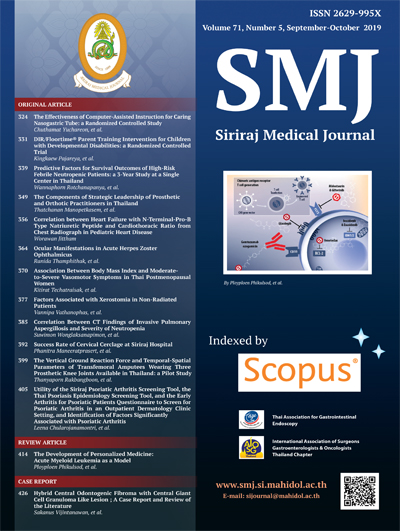Correlation Between CT Findings of Invasive Pulmonary Aspergillosis and Severity of Neutropenia
DOI:
https://doi.org/10.33192/Smj.2019.58Keywords:
Aspergillosis; neutropenia; CT scan; lung; pulmonaryAbstract
Objective: The purpose of this study was to investigate the association between CT findings of invasive pulmonary aspergillosis and neutrophils level.
Methods: This retrospective study included the patients diagnosed with invasive pulmonary aspergillosis by computed tomography (CT) at Siriraj Hospital (Bangkok, Thailand) during May 2006 to May 2010. The patients were classified into two groups: group I = neutrophils <500 cells/mm3, and group II = neutrophils ≥500 cells/mm3. Patient demographic and clinical data were collected. CT findings were compared between groups, including consolidation, pulmonary nodule, pulmonary mass, centrilobular nodule, CT halo sign, CT hypodense, air crescent, central cavity, lymphadenopathy, and pleural effusion.
Results: Of the 43 patients that were included, 14 patients were assigned to group I, and 29 patients were allocated to group II. The mean age of patients was 40.2 years, and 48.8% were male. The most common CT finding of invasive pulmonary aspergillosis was pulmonary nodules (83.7%), followed by CT halo sign (76.7%) and consolidation (69.7%). The CT finding that showed significantly more commonly in patients in group I and group II was consolidation (p=0.02) and central cavity (p=0.03), respectively.
Conclusion: Consolidation was the CT finding significantly most commonly observed in invasive pulmonary aspergillosis with neutrophils <500 cell/mm3, and central cavity was the finding significantly most commonly found in patients with neutrophils ≥500 cell/mm3 with non-specific distribution.
Downloads
Published
How to Cite
Issue
Section
License
Authors who publish with this journal agree to the following conditions:
Copyright Transfer
In submitting a manuscript, the authors acknowledge that the work will become the copyrighted property of Siriraj Medical Journal upon publication.
License
Articles are licensed under a Creative Commons Attribution-NonCommercial-NoDerivatives 4.0 International License (CC BY-NC-ND 4.0). This license allows for the sharing of the work for non-commercial purposes with proper attribution to the authors and the journal. However, it does not permit modifications or the creation of derivative works.
Sharing and Access
Authors are encouraged to share their article on their personal or institutional websites and through other non-commercial platforms. Doing so can increase readership and citations.















